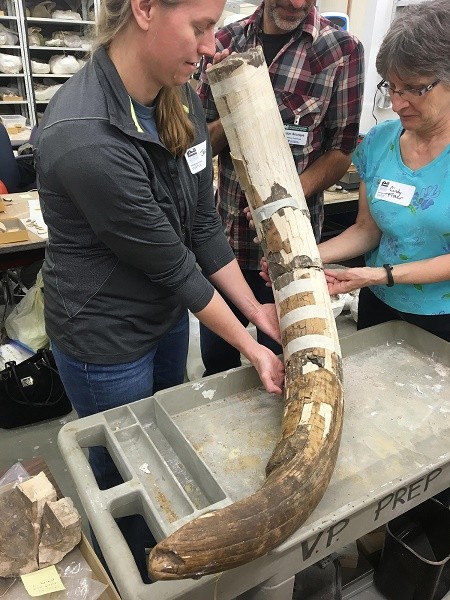Mastodon Tusk Reveals Ancient Humans Arrived in America Earlier Than First Thought
| Ana Verayo | | May 14, 2016 01:53 AM EDT |
(Photo : Daniel C. Fisher, University of Michigan Museum of Paleontology) Partly reassembled mastodon tusk from the Page-Ladson site in northwestern Florida. Curvature and size show this is an upper left tusk of a mature male mastodon. Tusk pieces held in place by Jessi Halligan of Florida State University (left), with assistance from Jason Bourque and Cynthia Darling-Fisher.
Researchers have uncovered the most crucial evidence yet of the first migration of man to North America, where stone tools and mastodon tusks were discovered in the Aucilla River in Florida, making them the oldest artifacts from human beings originating from the Southeast.
A team from the Florida State University and University of Michigan led by anthropology professor, Jessi Halligan, have determined these remnants as conclusive evidence that modern man was already present in Florida some 14,500 years ago.
Like Us on Facebook
Scientists found a knife with remarkable sharp edges on both of its sides suggesting that these were used to sever and detach the tusks from the mastodon's skull. The excavation site where these artifacts were uncovered was near a depressed area of a river known as the Page-Ladson site, where the tusk and tools were buried deep underwater at 30 feet.
American anthropologists and archaeologists will now have to re-evaluate the timeline of the migration of ancient humans to the Americas, as this discovery can push this human timeline back to at least 1,000 years. However, the site's discoveries were initially disregarded but after dating the artifacts, this new discovery can now be considered as proof that these are the first human settlers in Florida, before the Clovis culture arrived from Indiana.
Researchers believe that these newly discovered group of people most likely migrated from the western regions of North America, however, there are still no fossilized remains or skeletal remnants found on the site to determine the identity of these important ancestors. Another theory involves the migration of these ancient humans from Mexico, since the Gulf of Mexico was not yet as massive as it is today.
This new study is published in the journal, Science Advances.
TagsNorth America, America, Clovis, first humans in north america, ancient humans, mastodon tusk, Florida
©2015 Chinatopix All rights reserved. Do not reproduce without permission
EDITOR'S PICKS
-

Did the Trump administration just announce plans for a trade war with ‘hostile’ China and Russia?
-

US Senate passes Taiwan travel bill slammed by China
-

As Yan Sihong’s family grieves, here are other Chinese students who went missing abroad. Some have never been found
-

Beijing blasts Western critics who ‘smear China’ with the term sharp power
-

China Envoy Seeks to Defuse Tensions With U.S. as a Trade War Brews
-

Singapore's Deputy PM Provides Bitcoin Vote of Confidence Amid China's Blanket Bans
-

China warns investors over risks in overseas virtual currency trading
-

Chinese government most trustworthy: survey
-

Kashima Antlers On Course For Back-To-Back Titles
MOST POPULAR
LATEST NEWS
Zhou Yongkang: China's Former Security Chief Sentenced to Life in Prison

China's former Chief of the Ministry of Public Security, Zhou Yongkang, has been given a life sentence after he was found guilty of abusing his office, bribery and deliberately ... Full Article
TRENDING STORY

China Pork Prices Expected to Stabilize As The Supplies Recover

Elephone P9000 Smartphone is now on Sale on Amazon India

There's a Big Chance Cliffhangers Won't Still Be Resolved When Grey's Anatomy Season 13 Returns

Supreme Court Ruled on Samsung vs Apple Dispute for Patent Infringement

Microsoft Surface Pro 5 Rumors and Release Date: What is the Latest?










